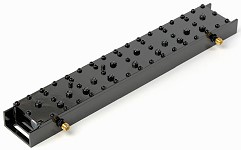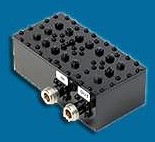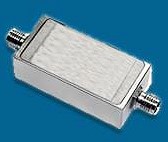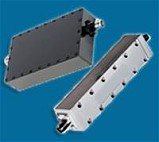Anatech Electronics January 2022 Newsletter |
||

Press Release Archives: 2024 | 2023 | 2022 | 2021 |2020 2019 | 2018 | 2017 | 2016 | 2015 2014 | 2013 | 2012 | 2011 | 2010 2009 | 2008 | 2007 | 2006 | 2005 Content is copyright of company represented. Page format, custom text and images are RF Cafe copyright - do not distribute.
Sam Benzacar of Anatech Electronics, an RF and microwave filter company, has published his January 2022 newsletter that features his short op−ed entitled "AM Radio Is Not Dead. Yet.," where he surveys the current AM landscape including listener demographics, current technology, and FCC regulations. As a lifelong AM listener myself, I definitely fit into the age-60-ish typical adherent, and talk radio is my primary daytime programming preference. In the evenings I switch over to FM music stations. Over the air broadcasting is also still my choice, and my radios typically use dials connected to variable capacitors - no electronic pushbutton tuning. Most AM and FM stations also offer Internet-based access, where all of the static, fading, and other forms of signal degradation are eliminated. Truthfully, those "annoyances" are nostalgia to my 64-year-old ears, so I don't mind needing to occasionally reorient an antenna or tweak the dial a bit for good reception. Sam believes - probably correctly - that AM radio will be gone by the end of this decade. The way things are going, I'll be gone by then as well, so hopefully AM broadcasts will hold on just a little while longer. A Word from Sam Benzacar AM Radio Is Not Dead. Yet.
The most surprising thing about AM radio broadcasting is that is still here. It's battled regulations that mandate power reductions after sundown, unfavorable propagation conditions, extreme sensitivity to electrical noise, limited audio bandwidth, and truly mediocre AM sections in vehicle radio receivers. Nevertheless, it has a strong following for those interested in news, weather, traffic, and sports, but these can increasingly be found on FM as well. However, the most potent factor that will lead to its demise is the dwindling number of people who listen to it. The average age of an AM radio listener is approaching 60, and according to the FCC among people aged 25 to 34, AM accounts for about 7% of radio listening. In fact, I'd bet that most people under the age of 30 have never even clicked the AM button on their vehicle infotainment display to see what's available.
But Tesla is not alone because during the ongoing supply chain crunch, some automakers toyed with the idea of leaving out the AM radio receiver on new models, which gives you an idea of how "ancient modulation" is viewed by the auto industry. Not only that, but AM radio reception appears problematic for the future as vehicles become entirely electrical and electronic, as noise is one of the primary factors that make AM radio annoying. Let's face it, AM radio reception has always been terrible, which is why it's best suited for talk but not music. I've had three vehicles with digital HD radio, none of which provided reception much better than analog version and the HD effect dropped in and out periodically. And I doubt any automaker spends much time thinking about how to improve its AM radio receivers. In addition, nothing can defy the disastrous effect of propagation after dark that reduces ground wave transmission. Worse still, the FCC remains firm in requiring AM stations to reduce their output power after sundown, which makes low-power stations such as National Public Radio all but unlistenable. So, is AM radio on its way out? I'd be willing to wager that by 2030 it may be gone from almost all vehicles. The auto industry is focusing on EVs and by that time the average age of listeners will have risen even further, reducing the total number of people who are interested. Time, and technology, marches on. We can always find a solution!
FCC Auction Nets $22.5B
Verus Gets DARPA High-Power Microwave Contract
Space X Launches Latest Smallsat Salvo
DoD Completes Ballistic Missile Detection Radar
Getting Ready for 5G: Anatech Electronics introduce New Ka band 30.5 GHz Waveguide Band Pass Filter. Featuring a center frequency of 30.5 GHz, a bandwidth of 1000 MHz, an Insertion Loss 1 dB Max, and a Power Handling is 20 watts.
Anatech Electronics Introduces a New Line of Suspended Stripline and Waveguide Type RF Filters
Check out Our Filter Products
Cavity Band Pass Filters LC Band Pass Filters Cavity Bandstop/Notch Filter About Anatech Electronics Anatech Electronics, Inc. (AEI) specializes in the design and manufacture of standard and custom RF and microwave filters and other passive components and subsystems employed in commercial, industrial, and aerospace and applications. Products are available from an operating frequency range of 10 kHz to 30 GHz and include cavity, ceramic, crystal, LC, and surface acoustic wave (SAW), as well as power combiners/dividers, duplexers and diplexers, directional couplers, terminations, attenuators, circulators, EMI filters, and lightning arrestors. The company's custom products and capabilities are available at www.anatechelectronics.com. Contact: Anatech Electronics, Inc. 70 Outwater Lane Garfield, NJ 07026 (973) 772-4242
Posted January 20, 2022 |
||

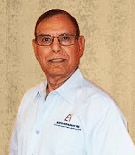 By Sam Benzacar
By Sam Benzacar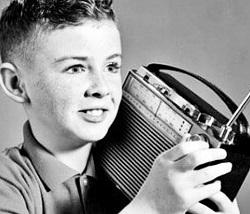 Demographics
like this do not bode well for AM in the future, regardless of efforts such as HD
Radio to make it more appealing and better suited to music, and a variety of efforts
to "save AM radio" by radio talk show hosts over the years. Tesla even went as far
as to remove both AM and FM radio and even Sirius XM from its Model S and Model
X model when it upgraded its master computer unit on older models to accommodate
company's Tesla Theater (video streaming), Tesla Arcade (video games), and TeslaCam
and Sentry Mode. To get it back you'd need to cough up $500 for a "radio retrofit".
Demographics
like this do not bode well for AM in the future, regardless of efforts such as HD
Radio to make it more appealing and better suited to music, and a variety of efforts
to "save AM radio" by radio talk show hosts over the years. Tesla even went as far
as to remove both AM and FM radio and even Sirius XM from its Model S and Model
X model when it upgraded its master computer unit on older models to accommodate
company's Tesla Theater (video streaming), Tesla Arcade (video games), and TeslaCam
and Sentry Mode. To get it back you'd need to cough up $500 for a "radio retrofit".
 AT&T, Dish,
and T-Mobile were the major bidders in the FCC's latest auction. AT&T spent
$9 billion, Dish spent $7.3 billion, and T-Mobile spent $2.9 billion. Total bids
reached about $22.5 billion, the third-largest FCC spectrum auction to date, following
last year's $80 billion C-band auction (half going to Verizon), and 2015's $44.9
billion AWS-3 auction. Collectively, the 3.45 GHz band and the neighboring 3.5 GHz
and 3.7 GHz bands represent 530 MHz of mid-band spectrum for 5G. Thirteen of the
23 companies with winning bids qualified as small businesses or as entities serving
rural communities. Compared to the prior 5G auction, this one showed an increase
in the number of winning bidders per market: More than one-third of the top 100
markets have at least four winning bidders, compared with 10% of the top 100 markets
in the last auction.
AT&T, Dish,
and T-Mobile were the major bidders in the FCC's latest auction. AT&T spent
$9 billion, Dish spent $7.3 billion, and T-Mobile spent $2.9 billion. Total bids
reached about $22.5 billion, the third-largest FCC spectrum auction to date, following
last year's $80 billion C-band auction (half going to Verizon), and 2015's $44.9
billion AWS-3 auction. Collectively, the 3.45 GHz band and the neighboring 3.5 GHz
and 3.7 GHz bands represent 530 MHz of mid-band spectrum for 5G. Thirteen of the
23 companies with winning bids qualified as small businesses or as entities serving
rural communities. Compared to the prior 5G auction, this one showed an increase
in the number of winning bidders per market: More than one-third of the top 100
markets have at least four winning bidders, compared with 10% of the top 100 markets
in the last auction.  Verus Research has been
awarded a $5 million Waveform Agile RF Directed Energy (WARDEN) contract from the
Defense Advanced Research Projects Agency (DARPA) that if all options in the 48-month
contract are exercised, will develop hardware, theory, and computational models
to extend the range and effectiveness of high-power microwave (HPM) systems. The
contract focuses on electromagnetic interactions with electronics contained within
enclosures and the effects on system operation. Verus Research will focus on researching
and modeling the fundamental physical factors that govern the nonlinear back-door
interaction of high-power radio frequency energy with complicated electronic systems
of interest.
Verus Research has been
awarded a $5 million Waveform Agile RF Directed Energy (WARDEN) contract from the
Defense Advanced Research Projects Agency (DARPA) that if all options in the 48-month
contract are exercised, will develop hardware, theory, and computational models
to extend the range and effectiveness of high-power microwave (HPM) systems. The
contract focuses on electromagnetic interactions with electronics contained within
enclosures and the effects on system operation. Verus Research will focus on researching
and modeling the fundamental physical factors that govern the nonlinear back-door
interaction of high-power radio frequency energy with complicated electronic systems
of interest.  SpaceX is set to double
its cadence of dedicated rideshare missions this year, beginning with the latest
Falcon 9 rocket launch from Cape Canaveral with 105 spacecraft destined for customers
in 20 countries. The company's first mission, Transporter 1, deployed 143 small
satellites in January 2021, and Transporter 2 carried 88. The payloads on Transporter
3 consist of those about the size of a soda can to that over washing machine, the
biggest of which is the Ukrainian Sich 2-1 satellite, a 375-lb. Earth-imaging spacecraft.
The Sich 2-1 satellite, also named Sich 2-30, was built by the Ukrainian company
Yuzhnoye and hosts a medium-resolution imaging payload to image Earth's surface
at visible and near-infrared wavelengths, collecting data useful in urban planning,
crop management, and environmental monitoring. Radar remote sensing satellites are
also part of the Transporter 3 payload package.
SpaceX is set to double
its cadence of dedicated rideshare missions this year, beginning with the latest
Falcon 9 rocket launch from Cape Canaveral with 105 spacecraft destined for customers
in 20 countries. The company's first mission, Transporter 1, deployed 143 small
satellites in January 2021, and Transporter 2 carried 88. The payloads on Transporter
3 consist of those about the size of a soda can to that over washing machine, the
biggest of which is the Ukrainian Sich 2-1 satellite, a 375-lb. Earth-imaging spacecraft.
The Sich 2-1 satellite, also named Sich 2-30, was built by the Ukrainian company
Yuzhnoye and hosts a medium-resolution imaging payload to image Earth's surface
at visible and near-infrared wavelengths, collecting data useful in urban planning,
crop management, and environmental monitoring. Radar remote sensing satellites are
also part of the Transporter 3 payload package. 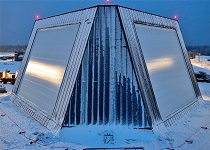 The Missile Defense
Agency, Northern Command, and Space Force I've completed construction of the long-range
discrimination radar (LRDR) site at Clear Space Force Station, Alaska. The multi-mission
LRDR is designed for initially improving incoming ballistic missile tracking and
combines lower frequency radars that can track multiple objects in space at long
range with higher-frequency radars that are better able to discriminate between
multiple objects. Ballistic missiles remove portions of their structure throughout
their trajectory including decoys and other countermeasures, and LRDR will help
determine those required to be targeted. When the system becomes fully operational,
the 220-deg. field of view provided by arrays 60 ft. high by 60 ft. wide will allow
search, track, and discrimination of small objects, including all classes of ballistic
missiles. In the future, the radar will be able to track hypersonic missiles as
well.
The Missile Defense
Agency, Northern Command, and Space Force I've completed construction of the long-range
discrimination radar (LRDR) site at Clear Space Force Station, Alaska. The multi-mission
LRDR is designed for initially improving incoming ballistic missile tracking and
combines lower frequency radars that can track multiple objects in space at long
range with higher-frequency radars that are better able to discriminate between
multiple objects. Ballistic missiles remove portions of their structure throughout
their trajectory including decoys and other countermeasures, and LRDR will help
determine those required to be targeted. When the system becomes fully operational,
the 220-deg. field of view provided by arrays 60 ft. high by 60 ft. wide will allow
search, track, and discrimination of small objects, including all classes of ballistic
missiles. In the future, the radar will be able to track hypersonic missiles as
well. 
